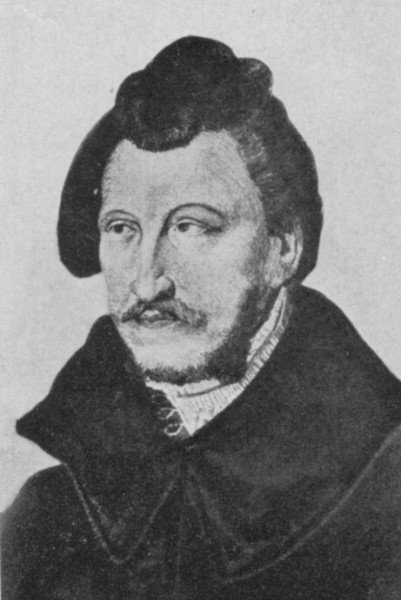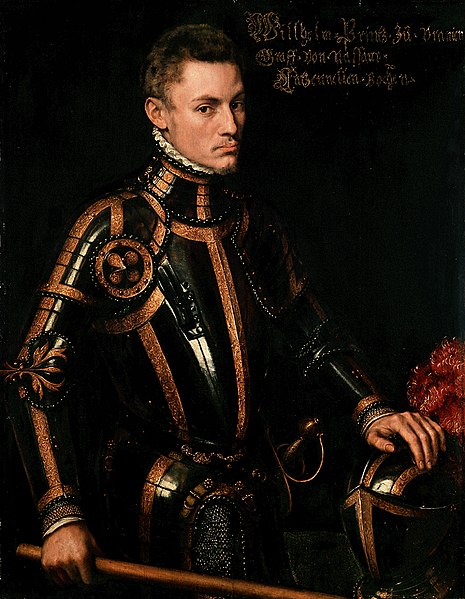 |
| Dillenberg |
Youth
 |
| William, Count of Nassau |
William was born on 24th April
1533, in Dillenberg in the duchy of Nassau[i]. He was the son of William, the Count of Nassau and his wife Juliana, daughter of Bodo III of Stolberg-Wernigerode.
William was the oldest of 12 children that his mother had by her second
husband. Juliana was William’s cousin and had been his ward. They married when
Juliana was 26. William’s birth was recorded by his father;
‘The highborn Julian von
Stolberg, Countess and Lady of Nassau, between two and three in the morning –
but nearer to three – in the castle of Dillenberg, gave birth to an infant of
the male sex: he shall be called William.’[ii]
By her
previous marriage to Count Philipp II of Hanau-Münzenberg, Juliana had five children. Count
William had two daughters by his previous marriage to Walburga of Egmont[iii]. All seventeen surviving children
were raised together as Lutherans. The year after William’s birth his father changed his religion and
reformed the churches in Nassau-Dillenburg; a quiet agricultural backwater
where the reforms raised no storm of protest.
Count
William was not a wealthy man and he and Juliana set up a school for the
children of the nobility. The school’s headmaster was Justus Hoen of Gelnhausen. The children were taught music and dancing in addition to
religion and more academic subjects. Juliana was involved in teaching the
girls, but her influence was felt throughout the school as her husband was
involved with his estates.
A Sea Change
.jpg/480px-'Portrait_of_Hendrik_III%2C_Count_of_Nassau-Breda'%2C_oil_on_panel_painting_by_Jan_Gossart_(Mabuse).jpg) |
| Henry III, Count of Nassau-Breda |
Count
William was a younger son; his older brother Henry III of Nassau-Breda inherited the major portion of the Nassau lands[iv] from their uncle Engelbert II. Henry was a close confidant of Charles V[v], the Holy Roman Emperor and King of Spain. Henry’s wife was Claudia of Chalon; their son René of Chalon inherited the principality of Orange from Claudia’s brother Philibert.
When William
was 11 on 15th July 1544, René died in the siege of St Dizier[vi], leaving his principality to his
young cousin on the understanding that William would henceforth be raised a
Catholic. Charles V was adamant that this vast inheritance[vii] not be passed on to a
heretic and in choosing René’s heir it was decided that a child would be more
malleable. William was now William of Orange-Nassau, Prince of Orange in far off France.
The estates however came loaded with debt.
William
renounced his paternal inheritance in favour of his brother John and left for the uncharted waters of
the imperial court at Coudenberg, [viii]under the tutelage of Mary of Hungary, the emperor’s sister and Regent of
the Netherlands. Charles was much taken with the confiding young boy and so was
Mary. These two powerful adults were to be the main influences during William’s
adolescence.
Growing Up
%2C_Queen_of_Hungary.jpg/503px-Mary_(1505%E2%80%931558)%2C_Queen_of_Hungary.jpg) |
| Mary of Hungary |
Mary and
Charles impressed upon William the duty of a ruler towards his subjects, a
sense of duty that was to be paramount for William in later years. But William
was closer to the common man than Charles and Mary could ever be. William was
an affable character who got on with most people; he was courteous to all he
met, no matter what their station in life.
‘He was marvellously clever
at gaining the hearts of those who spoke with him, were it only once; so well
did he understand how to accommodate his humour to that of other men, and to
enter into their interests.’[ix]
William’s military education was placed under the
direction of Jérôme Perrenot de Granvelle, son of Charles’ Chancellor Nicholas
Perrenot de Granvelle. William gradually grew to admire his adopted country; he spent a lot of
his free time riding round the countryside meeting the Dutch.
 |
| Prince Philip |
When he was
sixteen William was placed in charge of the official welcoming ceremony for the
twenty-two year old Prince Philip, Charles’ son, when he arrived in Breda. The two young men jousted together. Charles failed to notice that unattractive
Philip developed an immediate antipathy to William.
Philip was
an awkward, inarticulate, shy and neurotic young man who felt his inadequacies
were shown up by the younger William’s self-confidence and popularity; it stung
his pride. One thing the two had in common was their obstinacy and they shared
one interest; the literature of chivalry. In February 1551 Philip and William
again crossed lances in a carnival tourney in Augsburg.
Learning the Arts
In the
spring of 1550, when William was 17, Charles made him a mediator, along with
Count William von Neuenahr, in a dispute with the city of Cologne[x]. At the age of 18 in 1551 William
was given his first army command, rising to the rank of Colonel the following
year. The country was at war with France, under the leadership of Henry II, over hegemony in Italy, long a bone of contention between
the two countries.
 |
| Prince William of Orange |
When he was
twenty William was made Lieutenant-General of all the troops in the
Netherlands. William claimed that his monthly salary of 300 florins[xi] barely covered the cost
of the hands who put up and took down his tents.
Living in
court changed William from a confiding child to a young man who kept his own
counsel. Even so, as a young officer, William was charged with tracing a
corporal who dared to criticise the Regent. He excused himself from the duty,
the first sign of his unwillingness to accept orders he did not think right. He
was charming but could be excessively obstinate when he was convinced he was in
the right.
William
learnt to hide his feelings; he was in daily contact with two of the most
powerful people in Europe. As Gentleman of the Bedchamber to the Emperor, William
was in a position to observe the comings and goings around Charles, who trusted
him. William was allowed to stay and observe meetings between the Emperor and
foreign ambassadors.
Marriage
 |
| Anna von Egmont |
Charles
arranged the marriage of his favourite ward when William was 18. His chosen
bride was Anne van Egmont, only child of the wealthy Maximilian van Egmont, Count of Buren. The marriage took place on 8th July 1551. Anne suffered from
ill-health and had few interests outside court life and improvements at the
various properties the couple owned. On their first wedding anniversary,
separated by William’s military responsibilities, he wrote to her;
‘I long for you every day
more keenly if you were here you would certainly keep me warm at night.’[xii]
The joys of
marriage wore thin and after six years William was proclaiming to his
contemporaries that wives were for ‘founding
dynasties’, but not for pleasure. While Anne told a friend that she knew
William no better after six years than when they first got married.
Just before
the marriage William took over management of his estates. He did not forget his
family who were invited to his home at Breda and William gave his third brother
Louis a leg up in the Imperial army. His
mother came to be bedazzled by the riches on show at Breda and William
intervened in law suit on his father’s behalf.
William was
generous and overspent his income; much of his revenue from his estates was reinvested
for his tenants’ welfare and he was responsible for the pay of the troops under
his command. As Charles’ ill-health led him to withdraw from more and more of
his official engagements and as Philip[xiii] was a poor host, it
fell to William to host ambassadors and the cost of the entertainment fell upon
him.
On 22nd
November 1553 Maria van Nassau was born[xiv]. A year later, on 19th
December 1554 Anna gave birth to Philip William. On 7th February 1556
Anna gave birth to her third and last child, another Maria van Nassau.
Bibliography
The Age of
Religious Wars – Richard S Dunn, Weidenfeld & Nicholson 1971
The Revolt
of the Netherlands – Pieter Geyl, Cassell History 1988
The Holy
Roman Empire – Friedrich Heer, Phoenix 1995
Philip II –
Henry Kamen,
Charles V –
Harald Kleinschmidt, Sutton Publishing Ltd 2004
Emperor
Charles V – James D Tracy, Cambridge University Press 2002
William the
Silent – CV Wedgewood, Readers Union Ltd 1945
The
Hapsburgs – Andrew Wheatcroft, Folio Society 2004
[ii]
William the Silent - Wedgewood
[iv]
Henry was one of those accompanying Philip the Handsome
and Juana la Loca
to Castile in 1501
(see Juana
la Loca III)
[v]
Son of Philip the Handsome and Juana la Loca
[vii]
Comprising about ¼ of Brabant
and large swathes of Luxembourg, Flanders, Franche-Comté, the Dauphiné and the County of Charolais,
in total about £170,000 per annum; in 2014 the relative: historic standard of
living value of that income or
wealth is £81,790,000.00 economic status
value of that income or wealth is £2,650,000,000.00 economic power value of that income or wealth is £32,340,000,000.00
www.measuringworth.com
[ix]
William the Silent - Wedgewood
[x]
Only a minor dispute over details of Charles’ arrival in the city, but
indicative of the confidence Charles had in William
[xi]
In 2014
the relative: historic standard of living value of that income or wealth is £113,800.00 economic status value of that income or wealth is £3,834,000.00 economic power value of that income or wealth is £43,860,000.00 www.measuringworth.com
[xii]
William the Silent - Wedgewood
[xiii]
Who became a virtual recluse
[xiv]
Maria died in July 1555
No comments:
Post a Comment
Note: only a member of this blog may post a comment.